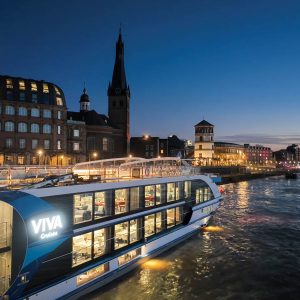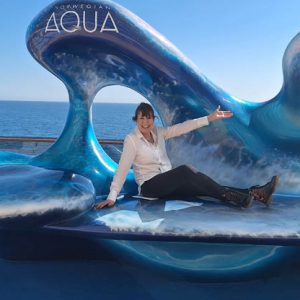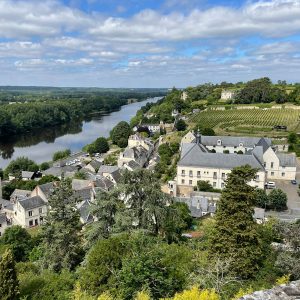The Dolphin and the Marauders
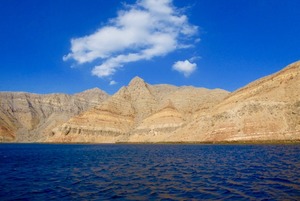 Head north east from Dubai along the Arabian coastline and the United Arab Emirates yields to Oman. At the tip of the coastline our first encounter with Oman is at Khasab, separated from Iran by the Strait of Hormuz. Spice is added to the modestly busy port with tales of smugglers scampering across the strait to cover the 55km to Iran under the cover of darkness. A free shuttle runs into the town from the port and we took a brief look to get a feel for local life. Not a huge amount to see apart from a mosque and goats running freely in the streets. The most popular attraction in this port, however, is a Dhow cruise. Comfortable cushions and carpets are laid out on the deck of the traditional wooden fishing vessel. Dubbed by some as the Norwegian fjords of the Gulf, it has a rugged charm all of its own. We enjoyed sampling the complimentary refreshments, including local dates, as we cruised along the arid Khors. The candy striped colours in the layers of rock, eroded with deep gouges over time are pleasing enough but it was the appearance of a pod of dolphins which was the icing on the cake.
Head north east from Dubai along the Arabian coastline and the United Arab Emirates yields to Oman. At the tip of the coastline our first encounter with Oman is at Khasab, separated from Iran by the Strait of Hormuz. Spice is added to the modestly busy port with tales of smugglers scampering across the strait to cover the 55km to Iran under the cover of darkness. A free shuttle runs into the town from the port and we took a brief look to get a feel for local life. Not a huge amount to see apart from a mosque and goats running freely in the streets. The most popular attraction in this port, however, is a Dhow cruise. Comfortable cushions and carpets are laid out on the deck of the traditional wooden fishing vessel. Dubbed by some as the Norwegian fjords of the Gulf, it has a rugged charm all of its own. We enjoyed sampling the complimentary refreshments, including local dates, as we cruised along the arid Khors. The candy striped colours in the layers of rock, eroded with deep gouges over time are pleasing enough but it was the appearance of a pod of dolphins which was the icing on the cake. 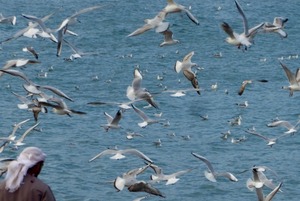 Feasting on the abundance of sardines in the water, they also frolic around the dhow creating childlike delight on board and cheering as they give chase when we speed off to our swim stop. I never tire of seeing these amazingly loveable creatures, also adept at quickly training humans to feed them free fish in captivity.
Feasting on the abundance of sardines in the water, they also frolic around the dhow creating childlike delight on board and cheering as they give chase when we speed off to our swim stop. I never tire of seeing these amazingly loveable creatures, also adept at quickly training humans to feed them free fish in captivity.
Muscat (meaning safe anchorage) sits on the Tropic of Cancer and was our other port of call in Oman. It has been the capital since 1793 and we chose the Big Bus tour as the means of exploring it. Discounts on the tour price can be had by booking online in advance, either for Oman alone or a combo ticket covering other destinations in the region such as Dubai and Abu Dhabi. The Big Bus picks up and drops off right beside the ship and it’s worth contacting them to book a seat if you want to be on the first bus or two away after immigration formalities are concluded. As we toured Muscat you see the evidence of the Sultan’s control of development, which has led to expansion being outward rather than upward (like some of its neighbours in the UAE). 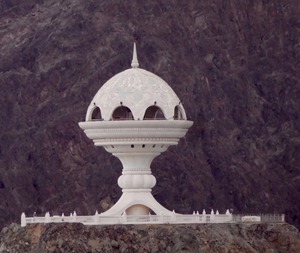 Whilst its neighbours may have secured the bragging rights on the biggest, tallest, etc. Muscat is understated and has kept true to its traditional architecture and charm. It’s immediately noticeable how a good percentage of the locals are wearing traditional dress.
Whilst its neighbours may have secured the bragging rights on the biggest, tallest, etc. Muscat is understated and has kept true to its traditional architecture and charm. It’s immediately noticeable how a good percentage of the locals are wearing traditional dress.
Many of Muscat’s attractions aren’t open to the public e.g. Parliament, Sultan’s Palace, Al Jalali Fort and Al Mirani Fort, so we enjoyed these from the bus, listening to the onboard commentary and sipping the complimentary bottled water. Relaxing and interesting as the commentary was, interspersed by people entertaining us by banging their head on the door frame (padded) right by the ‘Mind your Head’ sign, we were glad we got off to wander round. It was fun to explore the streets and see the locals at work and play. The best walk, however, can be done direct from the port where a complimentary shuttle takes you from the ship to the port gates. The walk to the old town is about 8km and is largely along the Mutrah Corniche (sea front). In many ways the Corniche reminds me of the Malecon in Havana, but whereas the Malecon is in desperate need of some TLC, the Corniche is well maintained and spotlessly clean. The walk takes you to the entrance of the Mutrah Souq but we chose to forego plunging into the hustle and bustle of the Souq and enjoy the simple pleasures of walking along in the sunshine. 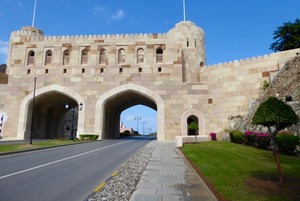 There are many things to admire including sculptures of dolphins and fish, fountains, Mosques and parks, or simply to watch a local feeding the seagulls and standing in a snowstorm of birds. We admired the incense burner on the top of the cliff, paying homage to the source of past posterity before cutting inland to the city gates. The Muscat gates kept the city secure from marauders and we were astonished to learn that it was as recent as the 1970s before the gates stopped being closed at night. Continuing on to the Sultan’s Palace we spotted the two forts set high on the cliffs guarding the harbour. These are remnants of the Portuguese occupation of Muscat in 1580s. Sharp eyes on the rocks behind the palace will spot graffiti left by HMS Perseus from circa 1910, when it was sent to help neutralise the trafficking of arms in this area. Although it’s not possible to go inside the Sultan’s Palace, we admired it from the gates outside and it marked a fitting end to a very enjoyable 48 hours getting to know Oman.
There are many things to admire including sculptures of dolphins and fish, fountains, Mosques and parks, or simply to watch a local feeding the seagulls and standing in a snowstorm of birds. We admired the incense burner on the top of the cliff, paying homage to the source of past posterity before cutting inland to the city gates. The Muscat gates kept the city secure from marauders and we were astonished to learn that it was as recent as the 1970s before the gates stopped being closed at night. Continuing on to the Sultan’s Palace we spotted the two forts set high on the cliffs guarding the harbour. These are remnants of the Portuguese occupation of Muscat in 1580s. Sharp eyes on the rocks behind the palace will spot graffiti left by HMS Perseus from circa 1910, when it was sent to help neutralise the trafficking of arms in this area. Although it’s not possible to go inside the Sultan’s Palace, we admired it from the gates outside and it marked a fitting end to a very enjoyable 48 hours getting to know Oman.

